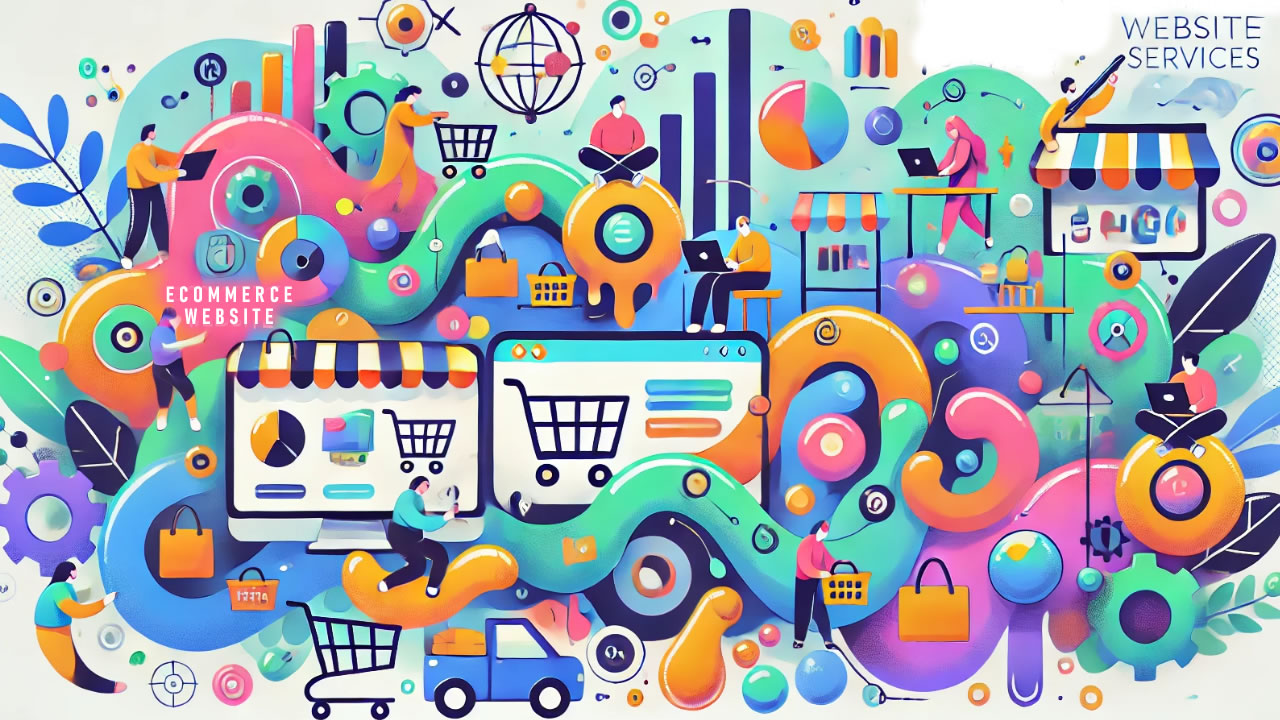Choosing the right eCommerce platform is crucial to the success of your online business. Whether you’re starting from scratch or migrating from other eCommerce platforms, it’s important to choose a solution that fits your needs and future growth plans. But with so many platforms available, how do you make the right choice?
In this guide, we’ll compare the top 7 eCommerce platforms, evaluating them based on critical factors like price, skill level, optional features, marketing tools, SEO capabilities, scalability, speed, and user experience. We’ll also rate each platform from 0-10 stars for each category, helping you make an informed decision.
Let’s dive into the top 7 eCommerce platforms and see how they stack up! Click a platform here to jump to that section: Shopify, WooCommerce, BigCommerce, Magento, Wix, Squarespace, OpenCart. Click here to compare the scores.
1. Shopify
Shopify is one of the most popular eCommerce platforms, known for its ease of use, scalability, and extensive app marketplace. It’s suitable for beginners as well as larger businesses looking to expand globally.
Benefits of Shopify
Ease of Use: Shopify is known for its intuitive, user-friendly interface, making it a top choice for beginners and small businesses. With its drag-and-drop builder, store setup is quick and requires no coding knowledge. Even those without a technical background can easily manage their store, update products, and track sales.
Extensive Features and Apps: Shopify offers a robust set of built-in eCommerce tools, including inventory management, secure payment gateways, and a streamlined checkout process. Additionally, Shopify’s app marketplace has over 7,000 apps, allowing users to extend functionality with marketing tools, product reviews, shipping integrations, and more. This level of customization makes it scalable for businesses of any size.
Scalability and Reliability: Shopify is highly scalable, capable of supporting both small shops and enterprise-level businesses with its Shopify Plus plan. Its hosting infrastructure is reliable, offering high performance, fast load times, and excellent uptime, which ensures a seamless shopping experience for customers.
Marketing and Multi-channel Selling: Shopify is optimized for marketing with built-in tools for SEO, email marketing, and social media integrations. It also supports multi-channel selling, allowing you to list products directly on platforms like Facebook, Instagram, and Amazon, expanding your sales reach.
Problems with Shopify
Cost: Shopify offers a range of plans starting at $39/month, but additional features like advanced reporting, lower transaction fees, and third-party apps can increase the overall cost. Moreover, if you don’t use Shopify Payments, transaction fees on top of credit card processing fees can add up, making it more expensive for some businesses.
Limited Customization for SEO: While Shopify is strong in SEO, it has some limitations in URL structure and metadata control compared to open-source platforms like WooCommerce or Magento. Customizing URLs, for example, isn’t as flexible, which could impact your ability to fully optimize SEO for specific needs.
App Dependency: Although Shopify’s app store offers a wealth of features, many essential tools require additional apps, which can lead to recurring fees. Businesses that need advanced customization or niche features may end up paying more over time to extend Shopify’s core functionality.
Rating Overview
Price: 8/10
Shopify’s pricing starts at $39 per month for the Basic plan, which is quite reasonable for small businesses. However, advanced features like better reporting and lower transaction fees require higher-tier plans, which can get pricey.
Easy to Setup: 9/10
Shopify is beginner-friendly, with a simple interface and drag-and-drop store builder. No coding skills are required, making it accessible for everyone.
Optional Features: 9/10
With over 7,000 apps in the Shopify App Store, you can add features like subscription services, advanced analytics, and custom themes. However, many apps come with additional costs.
Marketing: 9/10
Shopify excels in marketing tools, offering built-in email marketing, social media integration, and the ability to sell on platforms like Facebook and Instagram.
SEO: 8/10
Shopify’s SEO capabilities are strong, but URL customization is limited compared to other platforms, which can impact your ability to create SEO-friendly URLs.
Scalability: 10/10
Shopify is highly scalable, with plans that cater to small businesses and large enterprises alike. The Shopify Plus plan, designed for enterprises, supports huge traffic and sales volumes.
Speed: 9/10
Shopify is hosted on a secure, global CDN (Content Delivery Network), which ensures fast page load times, especially when optimized with apps like Shopify LiteSpeed.
User Experience: 9/10
Shopify’s clean, intuitive design makes it easy for store owners and customers to navigate. The platform is optimized for mobile and desktop users alike.
Overall Rating: 8.8/10
Shopify received an overall score of 8.8/10 due to its combination of ease of use, scalability, and extensive features. It’s highly accessible for beginners with its intuitive drag-and-drop interface, yet powerful enough for growing businesses with advanced needs, thanks to its robust app marketplace and enterprise-level scalability. Shopify excels in marketing and multi-channel selling, offering built-in SEO tools, email marketing, and social media integrations, making it ideal for businesses looking to grow online.
However, its slightly higher costs due to app dependency and some limitations in SEO flexibility prevented it from scoring higher. Despite these minor drawbacks, Shopify remains one of the best overall platforms for a wide range of eCommerce needs.

2. WooCommerce
WooCommerce is an open-source WordPress plugin that allows you to turn your WordPress website into an eCommerce store. It’s highly customizable and ideal for those who are already familiar with WordPress.
Benefits of WooCommerce
Flexibility and Customization: WooCommerce, as an open-source platform built on WordPress, offers unmatched flexibility. It gives you complete control over your website’s design, functionality, and content. With thousands of free and premium plugins and themes, you can tailor your store’s features to fit your exact business needs, from SEO optimization to product management and advanced analytics. This makes WooCommerce highly versatile, catering to businesses of any size or complexity.
SEO-Friendly: Since WooCommerce operates within WordPress, it inherits its powerful SEO capabilities. You can fully customize meta tags, URLs, and sitemaps, and utilize popular SEO plugins like Yoast SEO to improve your store’s visibility in search engine rankings. This makes WooCommerce an excellent choice for businesses looking to boost organic traffic through strong SEO practices.
Problems with WooCommerce
Technical Know-How Required: WooCommerce’s flexibility comes with a trade-off: it requires more technical skills than other hosted platforms like Shopify. While WooCommerce itself is free, you need to manage web hosting, domain setup, security, and regular updates. Beginners may find the setup and maintenance challenging, especially without prior experience with WordPress or eCommerce platforms.
Costs Can Add Up: While WooCommerce is free to install, running a fully functional store often involves additional expenses. You’ll need to pay for hosting, premium themes, plugins, and any necessary security features like SSL certificates. As your store scales, these costs can increase, especially if you require advanced functionalities or high-performance hosting to handle more traffic.
Rating Overview
Price: 9/10
WooCommerce is free, but you’ll need to pay for hosting, a domain, and any additional plugins or themes. This can either be cost-effective or expensive, depending on your needs.
Easy to Setup: 6/10
While WooCommerce is highly flexible, it requires some familiarity with WordPress. Beginners may find it challenging to set up without prior knowledge of WordPress.
Optional Features: 10/10
As an open-source platform, WooCommerce offers nearly unlimited customization options. With thousands of plugins and themes, you can create a fully personalized store.
Marketing: 7/10
WooCommerce does not offer built-in marketing tools, but you can integrate third-party solutions. Many premium marketing plugins are available but can add to the cost.
SEO: 10/10
Since WooCommerce runs on WordPress, it inherits WordPress’s excellent SEO capabilities. You can fully control URLs, meta tags, and use powerful SEO plugins like Yoast SEO.
Scalability: 8/10
WooCommerce can scale effectively with the right hosting, but large stores may require more advanced technical knowledge to optimize for performance.
Speed: 7/10
Speed depends on your hosting provider and how well you optimize your website. Poorly configured WooCommerce stores can be slow without the proper resources.
User Experience: 8/10
The flexibility of WooCommerce allows for great user experiences, but customization can get complex, especially for beginners.
Overall Rating: 8.1/10
WooCommerce received an overall score of 8.1/10 because of its exceptional flexibility, customization options, and powerful SEO capabilities. As an open-source platform built on WordPress, WooCommerce offers nearly unlimited control over design and functionality, making it ideal for businesses that require a tailored eCommerce solution. Its strong SEO features, such as the ability to customize URLs and meta tags, further boost its appeal for businesses focused on organic traffic growth.
However, its lower score comes from the technical skills required for setup and maintenance, as well as the hidden costs that can arise from hosting, premium plugins, and additional security measures. While WooCommerce is highly adaptable, it’s best suited for users with some technical expertise or those willing to invest in ongoing development.
3. BigCommerce
BigCommerce is a fully hosted platform designed to scale with growing businesses. It offers a variety of built-in features, reducing the need for third-party apps.
Benefits of BigCommerce
Scalability and Built-in Features: BigCommerce is designed to support businesses at all stages of growth, from small startups to large enterprises. It offers an extensive range of built-in features, such as multi-channel selling, advanced product management, and abandoned cart recovery, reducing the need for third-party apps. This makes it easier to scale without having to invest heavily in additional tools as your store grows. Additionally, BigCommerce is ideal for businesses with large product catalogs or high-volume sales, as it can handle complex inventories and traffic spikes seamlessly.
SEO and Performance: BigCommerce excels in SEO, providing features like customizable URLs, built-in blogging, and full control over meta data. These tools help improve search engine rankings and attract more organic traffic. The platform also delivers excellent site speed and uptime, ensuring a fast and reliable shopping experience for your customers, which is crucial for reducing bounce rates and increasing conversions.
Problems with BigCommerce
Higher Pricing for Growth: While BigCommerce offers competitive pricing at the entry level, its pricing model is based on your store’s annual revenue, which means as your sales grow, you may be required to upgrade to more expensive plans. This can make it costlier for high-revenue stores compared to other platforms, especially if you’re looking for additional features or enterprise-level solutions.
Learning Curve for Beginners: BigCommerce, while offering a comprehensive set of tools, has a steeper learning curve compared to platforms like Shopify or Wix. Its vast feature set may be overwhelming for beginners, especially those without eCommerce or technical experience. Though it’s designed for scalability, small business owners or first-time store owners might find it challenging to navigate initially without some guidance or support.
Rating Overview
Price: 7/10
BigCommerce’s pricing starts at $39 per month, similar to Shopify. However, its higher-tier plans are slightly more expensive. There are no transaction fees, which is a bonus.
Easy to Setup: 8/10
BigCommerce offers a user-friendly interface but has a steeper learning curve compared to Shopify. Some technical knowledge is helpful but not required.
Optional Features: 8/10
BigCommerce comes with many built-in features like advanced reporting, multi-currency support, and abandoned cart recovery. However, the app marketplace is not as large as Shopify’s.
Marketing: 8/10
BigCommerce offers good marketing tools, including social media integration, email marketing, and discounts. However, there are fewer options compared to Shopify’s extensive app ecosystem.
SEO: 9/10
BigCommerce offers robust SEO features, allowing you to fully customize URLs, meta tags, and alt text. It’s one of the better platforms for SEO optimization.
Scalability: 10/10
BigCommerce is designed for scaling, making it an ideal solution for fast-growing businesses. With built-in enterprise features, it can handle large volumes of traffic and transactions.
Speed: 9/10
BigCommerce delivers excellent site speed and performance, thanks to its robust hosting infrastructure.
User Experience: 8/10
BigCommerce offers a good balance of customization and ease of use, though some users may find the interface slightly more complex compared to Shopify.
Overall Rating: 8.4/10
BigCommerce received an overall score of 8.4/10 due to its robust set of built-in features, scalability, and strong SEO capabilities. The platform is well-suited for growing businesses, offering advanced tools like multi-channel selling, abandoned cart recovery, and customizable SEO options without the need for many third-party apps. Its ability to handle large product catalogs and high-traffic volumes makes it ideal for scaling eCommerce stores.
However, BigCommerce’s slightly lower score is due to its pricing structure, which increases as your sales grow, potentially making it more expensive for high-revenue businesses. Additionally, its comprehensive feature set can present a steeper learning curve for beginners, adding complexity for those new to eCommerce platforms.

4. Magento (Adobe Commerce)
Magento, now part of Adobe Commerce, is an open-source platform known for its robust features and flexibility. It’s suited for larger businesses with technical resources and development teams.
Benefits of Magento
Unmatched Customization and Flexibility: Magento (now Adobe Commerce) is one of the most powerful and flexible eCommerce platforms available. As an open-source solution, it offers nearly limitless customization options, allowing businesses to tailor every aspect of their store, from design and user experience to advanced features like complex product management and multi-store setups. This makes Magento ideal for large enterprises or businesses with specific needs that can’t be met by more standardized platforms.
Scalability and Feature-Rich: Magento is built to scale, making it a top choice for businesses that anticipate rapid growth or already operate at a large scale. It can handle massive product catalogs, large transaction volumes, and complex inventory management. Magento also comes packed with advanced features, including robust SEO tools, personalization options, and support for multi-channel selling, which helps businesses optimize for both organic search and customer engagement.
Problems with Magento
High Technical Demands: Magento’s flexibility comes with a significant trade-off—it requires advanced technical skills to set up, customize, and maintain. Businesses without in-house development teams may find it challenging to manage, as frequent updates and optimizations are necessary to keep the platform running smoothly. The need for technical expertise makes Magento a less viable option for small businesses or those without significant resources.
Expensive to Run and Maintain: While Magento’s open-source version is free, the costs associated with running and maintaining the platform can add up quickly. Hosting, security, performance optimization, and developer fees can be substantial, especially for larger stores or enterprise-level businesses using Magento’s premium Adobe Commerce edition. This makes Magento a costly option compared to other platforms like Shopify or WooCommerce, which offer more all-in-one solutions at a lower cost.
Rating Overview
Price: 5/10
The Magento Open Source version is free, but hosting, development, and extensions can add up quickly. Adobe Commerce’s pricing starts at around $22,000 annually for enterprise features.
Easy to Setup: 4/10
Magento requires significant technical expertise. It’s not a beginner-friendly platform and is best suited for businesses with in-house development teams.
Optional Features: 10/10
Magento’s feature set is nearly limitless. With thousands of extensions and customization options, Magento can handle virtually any eCommerce requirement.
Marketing: 8/10
Magento offers advanced marketing features, including customer segmentation, personalized promotions, and built-in email marketing options.
SEO: 9/10
Magento has strong SEO capabilities, allowing complete control over URLs, meta data, and sitemaps. However, you’ll need technical skills to optimize everything properly.
Scalability: 10/10
Magento is one of the most scalable platforms available, capable of handling millions of products and heavy traffic. This makes it a top choice for enterprise-level businesses.
Speed: 7/10
Magento can be fast, but it depends heavily on your hosting and the expertise of your development team. Poorly optimized Magento sites can suffer from slow load times.
User Experience: 7/10
The user experience is excellent for those with development resources, but for smaller businesses or less technical users, the complexity can be overwhelming.
Overall Rating: 7.5/10
Magento received an overall score of 7.5/10 due to its exceptional flexibility, customization, and scalability, making it a top choice for large businesses and enterprises with complex needs. It allows for complete control over every aspect of the eCommerce experience, from design to functionality, and is capable of handling large product catalogs and high traffic volumes. Magento also excels in advanced features like multi-store setups and robust SEO tools.
However, its lower score is due to the high technical demands and significant costs associated with running and maintaining the platform. Magento requires advanced development skills, and businesses without in-house technical teams may struggle with its complexity. Additionally, while the open-source version is free, hosting, security, and development fees can become expensive, making it less accessible for small to mid-sized businesses.
5. Wix eCommerce
Wix is a website builder with eCommerce functionality. It’s a great choice for small businesses or individuals looking for an easy-to-use platform to sell products online.
Benefits of Wix
Ease of Use and Design Flexibility: Wix is known for its incredibly user-friendly drag-and-drop website builder, making it a great option for beginners and small business owners with no technical experience. Setting up an online store is simple, and you can choose from a wide variety of professionally designed, customizable templates. This allows for a visually appealing and functional store without needing any coding skills. Wix’s intuitive design process and pre-built elements make it quick and easy to launch an eCommerce site.
Affordable Pricing with Built-In Features: Wix offers affordable pricing plans, making it a cost-effective choice for small businesses. The platform includes essential eCommerce tools like product galleries, inventory management, secure payment gateways, and automated sales tax calculators. Additionally, Wix provides useful marketing features, such as email marketing and social media integrations, helping you promote your products without needing to invest in third-party tools.
Problems with Wix
Limited Scalability and Advanced Features: While Wix is excellent for small to medium-sized businesses, it’s not ideal for stores that expect to scale significantly. As your business grows and your needs become more complex, Wix’s limitations in terms of advanced features and integrations may become a barrier. Its app market isn’t as extensive as platforms like Shopify or WooCommerce, and larger businesses may find the need for additional customization difficult to achieve.
SEO and Performance Limitations: Although Wix has improved its SEO tools, it still doesn’t offer the same level of control as platforms like WordPress (WooCommerce) or BigCommerce. The platform’s SEO capabilities are adequate for basic needs, but for businesses that heavily rely on organic search traffic, Wix’s lack of advanced optimization options may be limiting. Additionally, while Wix performs well in speed for small stores, larger, content-heavy websites may experience slower load times, impacting user experience and search engine rankings.
Rating Overview
Price: 8/10
Wix’s pricing is affordable, starting at $27 per month for the Business Basic plan. However, more advanced eCommerce features require higher-tier plans.
Easy to Setup: 9/10
Wix is known for its drag-and-drop editor, making it extremely easy for beginners to set up a store without any technical knowledge.
Optional Features: 7/10
Wix has an app market, but the selection is not as extensive as Shopify or WooCommerce. It offers basic eCommerce functionality but may lack some advanced features.
Marketing: 7/10
Wix offers built-in email marketing, social media integrations, and a few other marketing tools, but it’s not as comprehensive as Shopify or BigCommerce.
SEO: 7/10
Wix has made significant improvements in its SEO tools, but it’s still not as flexible as WordPress or Magento. SEO-savvy users may find the platform limiting.
Scalability: 6/10
Wix is ideal for small to mid-sized stores, but it may not be the best option for rapidly growing businesses with complex needs.
Speed: 8/10
Wix’s hosted infrastructure ensures decent site speed, but large stores with heavy content may experience slower load times.
User Experience: 9/10
Wix offers one of the most intuitive user experiences, both for store owners and customers. It’s visually appealing and optimized for mobile and desktop browsing.
Overall Rating: 7.6/10
Wix received an overall score of 7.6/10 due to its ease of use, design flexibility, and affordability, making it an excellent choice for small businesses and beginners. Its drag-and-drop builder allows users to quickly create visually appealing stores without any coding skills, and it offers a range of built-in features for eCommerce functionality, such as secure payment gateways and basic marketing tools.
However, Wix’s score is lowered by its limitations in scalability and advanced features. While suitable for small to medium-sized stores, it may struggle to meet the needs of larger businesses with complex operations. Additionally, its SEO and performance capabilities, while improving, are not as robust as those offered by more advanced platforms like WooCommerce or Shopify, limiting its effectiveness for businesses focused on scaling and long-term growth.
6. Squarespace Commerce
Squarespace is a website builder that combines beautiful design templates with eCommerce functionality. It’s an excellent option for creative businesses looking to sell products online.
Benefits of Squarespace
Beautiful Design and User-Friendly Interface: Squarespace is well-known for its stunning, professionally designed templates, making it an ideal choice for businesses that prioritize aesthetics, such as artists, designers, and creatives. The platform’s drag-and-drop interface makes it easy to build and customize an online store, even without technical expertise. With responsive design templates, your store will look polished and consistent across all devices, enhancing the user experience for both desktop and mobile shoppers.
Built-In Features for Small Businesses: Squarespace offers a solid set of built-in eCommerce tools, including inventory management, secure checkout, abandoned cart recovery, and product variants. These features are suitable for small to medium-sized businesses, allowing you to manage an online store without needing additional plugins or third-party apps. Squarespace also includes useful marketing tools, such as email marketing integration and social media selling, which can help boost your online visibility and sales.
Problems with Squarespace
Limited Scalability and Customization: While Squarespace works well for small businesses, it lacks the advanced features and flexibility needed to scale large eCommerce operations. Unlike open-source platforms like WooCommerce or Magento, it offers limited customization options, especially for businesses with complex product catalogs or specialized requirements. As your store grows, you might find the platform’s customization tools and third-party app integrations insufficient for more advanced needs.
SEO and Advanced eCommerce Features: Although Squarespace offers basic SEO tools, it doesn’t provide the depth of optimization control found in platforms like WooCommerce or BigCommerce. Businesses that rely heavily on organic search traffic may find Squarespace’s SEO capabilities somewhat restrictive. Additionally, Squarespace lacks some advanced eCommerce functionalities, such as extensive multi-channel selling options or highly customized shipping and tax features, which can be limiting for businesses looking to expand their operations beyond basic selling.
Rating Overview
Price: 7/10
Squarespace’s pricing starts at $33 per month for its Basic Commerce plan. It’s affordable, but some features are locked behind higher-tier plans.
Easy to Setup: 8/10
Squarespace is easy to use, with a drag-and-drop editor and beautiful templates. No coding skills are needed to get started.
Optional Features: 6/10
Squarespace offers fewer customization options and integrations compared to Shopify and WooCommerce, but it covers the basics well.
Marketing: 7/10
Squarespace includes built-in email marketing, social media integration, and discount codes, but lacks some advanced features for larger stores.
SEO: 7/10
Squarespace has good basic SEO tools but falls short compared to WordPress or BigCommerce when it comes to advanced SEO features.
Scalability: 6/10
Squarespace is ideal for small to medium-sized stores, but businesses looking to scale significantly may find it limited.
Speed: 8/10
Squarespace provides solid performance with fast load times and secure hosting infrastructure.
User Experience: 9/10
Squarespace is known for its stunning templates and clean, modern user interface. It’s optimized for great customer experiences across devices.
Overall Rating: 7.4/10
Squarespace received an overall score of 7.4/10 due to its beautifully designed templates and user-friendly interface, making it an attractive option for small businesses, creatives, and entrepreneurs who prioritize design. Its built-in eCommerce features are sufficient for managing smaller stores, with tools like inventory management, secure checkout, and marketing integrations that help simplify online selling without the need for extensive third-party apps.
However, its score is lowered by limitations in scalability, customization, and advanced features. Squarespace lacks the flexibility and robust integrations required by larger or fast-growing businesses. Its SEO tools, while adequate for basic needs, are not as powerful as those on other platforms like WooCommerce or BigCommerce. As a result, it’s better suited for smaller stores with straightforward eCommerce requirements.

7. OpenCart
OpenCart is an open-source platform that provides an affordable, flexible solution for online businesses. It requires hosting and some technical know-how, but it’s highly customizable.
Benefits of OpenCart
Affordable and Open-Source Flexibility: OpenCart is a free, open-source eCommerce platform, making it a cost-effective solution for businesses that want full control over their online store. Since you only need to cover hosting, domain, and any premium extensions, it’s a budget-friendly option compared to many paid platforms. OpenCart offers great flexibility, allowing businesses to customize the platform to meet their specific needs. With access to a large range of extensions and themes, businesses can tailor their store’s functionality and design to suit their requirements.
Multi-Store and Multi-Language Support: OpenCart is highly versatile in managing multiple stores from a single admin panel, making it ideal for businesses looking to operate multiple brands or regional storefronts. Additionally, it supports multiple languages and currencies out of the box, making it a good choice for businesses with an international audience. This built-in functionality allows store owners to efficiently manage diverse operations without needing significant additional plugins or custom coding.
Problems with OpenCart
Technical Knowledge Required: While OpenCart is flexible, it requires a higher level of technical expertise compared to platforms like Shopify or Wix. Setting up, maintaining, and optimizing an OpenCart store may involve dealing with coding, managing hosting, and installing third-party extensions, which can be challenging for users without technical experience. Regular updates, security patches, and troubleshooting issues often require developer assistance, adding to the cost and complexity.
Limited Scalability and Built-In Features: OpenCart offers fewer built-in features compared to platforms like BigCommerce or Shopify. Many essential features, such as advanced reporting, marketing tools, and SEO capabilities, require installing third-party extensions. While OpenCart can scale for larger businesses, it may require significant optimization efforts, and its performance can suffer if not properly managed. This makes it less ideal for fast-growing or large enterprises that need a robust, all-in-one solution without relying heavily on external modules.
Rating Overview
Price: 9/10
OpenCart is free to use, but you’ll need to pay for hosting, a domain, and extensions. However, it’s still an affordable option overall.
Easy to Setup: 5/10
OpenCart requires some technical knowledge to set up and customize. While it’s not as difficult as Magento, beginners may find it challenging.
Optional Features: 8/10
OpenCart offers a wide range of extensions and themes, making it customizable for different business needs. However, the extension marketplace is smaller than WooCommerce or Shopify.
Marketing: 6/10
OpenCart lacks built-in marketing tools, but you can add third-party plugins for email marketing, social media integration, and more.
SEO: 7/10
OpenCart offers decent SEO functionality, allowing you to customize URLs and meta tags, but it’s not as advanced as WooCommerce or Magento.
Scalability: 7/10
OpenCart can scale with your business, but performance can become an issue with large stores unless optimized properly.
Speed: 6/10
Site speed depends on your hosting and optimization efforts. OpenCart is not the fastest platform out of the box.
User Experience: 7/10
OpenCart’s user interface is simple but not as intuitive or modern as other platforms. Customization is possible but may require developer assistance.
Overall Rating: 7.0/10
OpenCart received an overall score of 7/10 due to its affordability, flexibility, and multi-store functionality. As a free, open-source platform, it provides businesses with the ability to customize their store and only pay for hosting and additional features as needed, making it a budget-friendly option. It also supports multi-store management and multiple languages, which is beneficial for businesses looking to expand internationally or manage multiple brands.
However, the platform’s lower score stems from its technical demands and limited built-in features. OpenCart requires more technical expertise for setup, maintenance, and optimization, making it challenging for users without coding experience. Additionally, many essential features, such as advanced marketing tools and SEO, must be added via third-party extensions, which can make it less convenient and scalable compared to other eCommerce platforms.
Comparing the Scores
Choosing the best eCommerce platform depends on your business’s specific needs, budget, and technical expertise. Here’s a quick summary of our ratings:
Shopify: 8.8/10 – Best for businesses looking for an easy-to-use platform with extensive marketing tools and scalability.
WooCommerce: 8.1/10 – Best for WordPress users who want full control over customization and SEO.
BigCommerce: 8.4/10 – Ideal for growing businesses that need built-in enterprise features and strong scalability.
Magento (Adobe Commerce): 7.5/10 – Best for large, enterprise-level businesses with technical resources.
Wix eCommerce: 7.6/10 – Great for small businesses or individuals who want an easy-to-use platform with beautiful design options.
Squarespace Commerce: 7.4/10 – Best for creative businesses that prioritize design and ease of use.
OpenCart: 7.0/10 – Affordable and flexible, but requires some technical know-how.
By understanding the strengths and weaknesses of each platform, you can choose the one that fits your business’s current needs and growth plans. Whether you’re starting small or planning to scale quickly, there’s an eCommerce solution that’s right for you!
Start Your eCommerce Website Today
Schedule A CallRead more about eCommerce

WooCommerce vs Shopify: What’s The Best Online Store For Me?

eCommerce Marketing: Proven Strategies to Increase Sales
